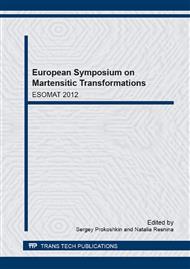p.321
p.326
p.332
p.338
p.344
p.348
p.352
p.357
p.362
Influence of Low Temperature Glow Discharge Nitriding and/or Oxiding Process on Structure and Shape Memory Effect in NiTi Alloy
Abstract:
In order to increase corrosion resistivity of the NiTi alloy the surface is covered by layers. Layers can be made from such as titanium nitrides and/or oxides as well as their mixture. Recently, a glow discharge technique has been applied for coatings formation. However, the deposition process requires to be done at elevated temperature. Therefore, it may have a negative effect on the structure, which is responsible for the shape memory phenomena. The results obtained from studies, done over the influence of the glow discharge nitriding and combination of nitriding and oxidizing process on the structure, the kinetics of martensitic transformation, the one-way shape memory effect and the superelasticity effect of the NiTi alloys are reported. The results showed that during deposition process, curried out at temperatures above 250°C and for time up to 30 minutes, the precipitation of dispersive particles of Ni4Ti3 phase already starts and has a positive effect on the superelasticity phenomena. The applied deposition technique does not affect also negatively the shape memory effect.
Info:
Periodical:
Pages:
344-347
Citation:
Online since:
January 2013
Price:
Сopyright:
© 2013 Trans Tech Publications Ltd. All Rights Reserved
Share:
Citation:


